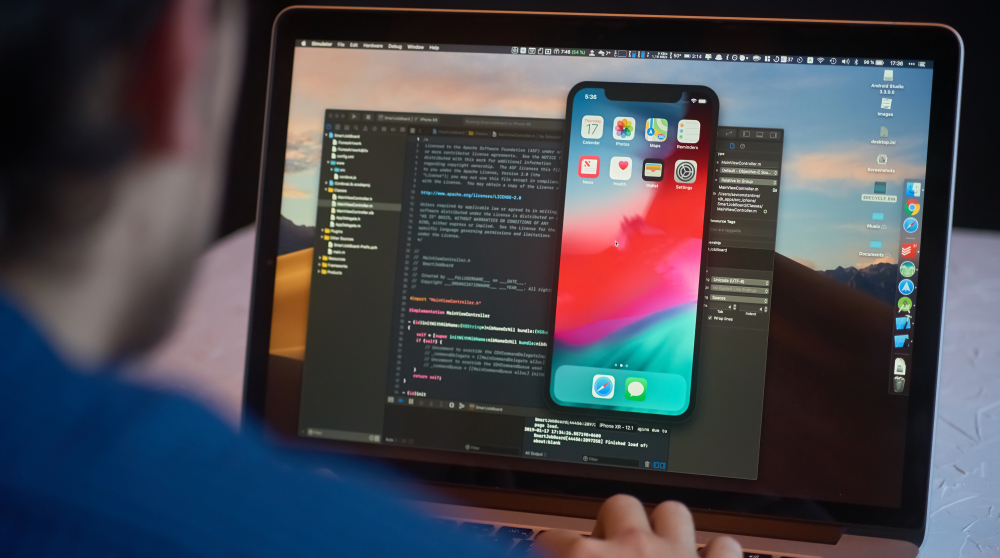In a world driven by innovation and technological advancement, turning a brilliant app idea into a successful reality demands careful planning and execution. From conceptualization to deployment, the journey entails a strategic roadmap that navigates challenges and leverages opportunities. This article unfolds the steps essential for transforming your app idea into a triumphant application, poised to resonate with users and achieve remarkable success.

1. The Ideation Phase: Crafting the Blueprint
-
Brainstorming Your Concept
At the genesis of every successful app lies a spark of inspiration, a seed from which innovation blossoms. This critical juncture initiates a process of brainstorming that extends beyond mere ideation; it is the crystallization of a visionary idea into a tangible form. You have to identify a problem or unmet need in the digital landscape that your app can adeptly address. This serves as the cornerstone of your app's concept and framework. By pinpointing this main issue, you provide your app with a specific purpose and a compelling value proposition, setting the stage for its distinctive identity.
As the framework takes shape, the focus widens to cover the whole market. In the digital ecosystem, there are other players—current competitors with their own products. Through thorough market research, you start to look around. Analyze these competitors, break down their strengths and weaknesses, and find out what makes them appealing. With this information, you can dig deeper to learn about user preferences and behaviors. Find out the subtle things that affect their decisions, habits, and wishes.
2. Defining Features and Functionality: Building a Solid Framework
As the initial stage transforms into a tangible concept, the process of molding your app's architecture and identity takes center stage. This important phase is like building the backbone of a big building, where each piece is carefully placed to make sure the whole thing works well.
-
Feature Prioritization: Setting the Stage for Excellence
With a clear and solid idea in mind, it's time to start thinking about the features your app will have. The wide world of possibilities beckons, but getting around in it takes planning and smart choices. This is where the art of feature prioritization comes in, which is a methodical way to figure out what your app is all about.
Each feature is looked at through the lens of how important and possible it is. What parts of the app are necessary for it to work? Which updates can be put off until later? By looking at each feature's usefulness and potential impact, you can set up a sequence that improves the user experience and keeps them interested.
This strategy for setting priorities not only speeds up the development process but also marks the start of the first version of your app, called the Minimum Viable Product (MVP). This carefully chosen group of features makes up the core of your app's identity and gives users the most value from the start.
-
User Flow and Interface Design: The Canvas of User Experience
Once all the features are in place, the focus moves from the backend to the user experience, which is the heart of your app's journey. Here, user flow and interface design become the guiding stars, showing users how to interact in a way that is smooth and enjoyable.
The way a user moves through your app's landscape must be clear and interesting. Wireframes and mockups can help with this. These visual blueprints show how each interaction works and show the user journey in a clear and concise way. The user interface, like the stage where the dance takes place, is made to be easy to use and fit with the purpose and style of your app.
Every screen, every button, and every action a user makes contributes to a seamless user experience that helps them reach their goals. This strategic design not only makes it easier to use, but it also makes it easier for people to get involved, making sure that users find something useful and enjoyable at every touchpoint.
3. Technical Development: Building the Foundation
-
Choosing the Right Platform
The first important part of this phase is the platform that your app will run on. You have to decide if your app will be native, which means it will only work on a specific platform like
iOS or
Android, or if it will use cross-platform development, which will allow it to reach a wider audience.
This choice has big effects on how many people can use your app, how it works for them, and how it is built. Native apps provide a more seamless and platform-specific experience, but cross-platform development can speed up the process and make your app more available to more people. This important choice affects the next steps and tells you what tools and technologies to use.
-
Selecting the Technology Stack: Laying the Bricks of Technology
After deciding on the platform, the next step is to choose the right technology stack. This is the group of programming languages, frameworks, and tools that make up your app's architecture. Just like an architect carefully chooses materials that go with the building they want to build, you need to choose technologies that work well with your app's specific needs.
This choice will affect many different parts of the process of making your app. Depending on which programming language you choose, you will be able to write and maintain code more or less quickly. The architecture and structure of your app will depend on the frameworks you choose, which will affect how well it works and how big it can get. The tools you use will make it easier for your development team to work together, which will keep things running smoothly.
In this phase, it's not enough to choose a set of languages and frameworks; you also need to build a system that will work well together and be the backbone of your app. This process involves careful thought, evaluation, and maybe a little bit of testing. The goal is to choose a technology stack that fits the needs of your app, improves performance, and sets the stage for the next stages of development.
4. Development and Iteration: Bringing Your App to Life
-
Minimum Viable Product (MVP)
As your app's plan comes together, the development phase becomes the forge where your vision takes shape. This important step gives your idea life, turning it into something real that users can touch and play with. It's a lot like sculpting a piece of art, because each line of code adds to the masterpiece you're making.
As your MVP is the first step in the journey of your app, the way you build it can have a big impact on its path. Agile development, a method that promotes adaptability, responsiveness, and the art of iteration, becomes the guiding philosophy.
With agile development, you release your app in stages or iterations. This method lets you respond to user feedback, add new features, and change your app to keep up with changing market trends. It's like a dance, where each step is a careful iteration and a calculated response to the changing rhythms of user interaction.
Iterations are not just bug fixes or small changes; they also include how your app's features, design, and user experience change over time. As you listen to user feedback and add new information, your app changes naturally, based on what users want and need.
The beauty of the agile method is that it can change quickly. It's not a one-way street where you just give out features. Instead, it's a dynamic, two-way conversation between your app and its users. This constant conversation builds trust and loyalty, making sure that your app is still useful and has a strong effect on its users.
5. Testing and Quality Assurance: Ensuring Performance
Before your app steps onto the digital stage, it must undergo a battery of tests to verify the precision and reliability of its features. Each aspect, from buttons to interactions, is meticulously scrutinized to ensure they operate exactly as intended. This process entails simulated interactions that mimic user behavior, systematically traversing through the app's landscape to uncover any hidden intricacies.
This stage isn't just about identifying bugs or glitches; it's about ensuring that the intricate gears of your app's mechanism are finely tuned and well-oiled. It's about guaranteeing that users' interactions are seamless, intuitive, and frustration-free. Any anomalies, discrepancies, or inconsistencies are swiftly identified, and a symphony of rectification is orchestrated to harmonize every element.
While functional testing paves the way for internal excellence, user testing opens the gateway to external insights. Real users, drawn from your target audience, become the judges of your app's usability, functionality, and overall experience. Their perspectives, unbiased by developer familiarity, unveil aspects that might have been overlooked during the development process.
User testing is a journey of revelation. Users engage with your app, navigating its landscape just as any potential user would. Their interactions yield invaluable insights – they might stumble upon hiccups that escaped your scrutiny or offer suggestions that enhance usability.
6. Deployment and Launch: Making Your App Public
-
App Store Optimization (ASO)
As your app finds its place in the digital marketplace, ensuring its visibility and discoverability becomes paramount. This is where
App Store Optimization (ASO) steps in – a deliberate process that tailors your app's presentation to resonate with the preferences of potential users.
Crafting an engaging title and description is akin to the introduction of a captivating story – it must intrigue and entice, offering a glimpse of the value that lies within. Relevant keywords, carefully chosen, act as signposts that guide users toward your app in the vast expanse of app stores. The visual allure of captivating visuals – icons, screenshots, and app previews – acts as a visual invitation, beckoning users to explore further.
App Store Optimization isn't merely a technical exercise; it's a strategic endeavor that places your app in the spotlight, positioning it for optimal discoverability. By fine-tuning these elements, you create a compelling narrative that resonates with users and draws them closer to your app's promise.
-
Marketing and Promotion: Cultivating Anticipation
A successful app launch is akin to orchestrating a grand symphony, where every note contributes to a harmonious crescendo of user engagement. The key to this orchestrated success lies in a well-crafted marketing and promotion strategy.
Before the curtain rises on your app's official launch, lay the groundwork for anticipation. A pre-launch marketing strategy acts as a prologue, generating excitement and buzz among your target audience. Leverage the power of social media platforms to tease your app's impending arrival, sparking curiosity and conversations.
Influencers, with their established reach and credibility, become your allies in amplifying your app's message. Collaborate with influencers whose audience aligns with your target demographic, creating a ripple effect that extends your app's reach to new corners of the digital sphere.
Beyond influencers, explore a diverse array of promotional channels – from email marketing to content marketing. Engage potential users through informative content that not only showcases your app's features but also highlights the unique value it brings to their lives.
7. Post-Launch Strategy: Sustaining and Scaling
As your app enters the digital realm and users start engaging with it, the journey is far from over. In fact, it's just the beginning of a new phase that involves nurturing your creation, gathering insights, and charting a path for growth. A well-crafted post-launch strategy is essential to sustain the momentum and scale your app's impact. Here are five key points to consider:
- User Feedback and Iterative Enhancement: The launch of your app marks the commencement of a dynamic feedback loop. Encourage users to provide feedback and reviews, and listen attentively to their opinions. User feedback is a treasure trove of insights, revealing what works well and what needs improvement. Leverage this feedback to prioritize updates and enhancements, ensuring that your app continually evolves to meet user expectations.
- Regular Updates and Feature Expansion: The digital landscape is ever-evolving, and your app should keep pace. Regular updates not only fix bugs but also introduce new features and improvements. This ongoing development showcases your commitment to delivering value and maintaining a vibrant user experience. Strategically expand your app's capabilities to address emerging trends or evolving user needs, fostering user engagement and retention.
- Performance Optimization and User Experience: A seamless user experience is the cornerstone of user satisfaction and retention. Continuously monitor your app's performance, paying attention to factors like loading times, responsiveness, and stability. Address any performance bottlenecks promptly to ensure a smooth experience for users across different devices and network conditions. A well-optimized app enhances user loyalty and positive word-of-mouth referrals.
- User Engagement Strategies: Engaging users beyond the initial launch is essential for long-term success. Implement strategies that maintain a strong connection with your audience. Push notifications, in-app messaging, and personalized content can keep users informed about updates, promotions, and relevant content. By fostering ongoing interaction, you create a sense of community and loyalty among your users.
8. Analytics and Insights: Monitoring Performance
- Implementing Analytics: Integrate analytics tools to monitor user behavior, engagement, and app performance. This data provides insights that guide decision-making and reveal opportunities for improvement.
- Iterative Improvement: Regularly analyze analytics data to identify usage patterns, user preferences, and pain points. Leverage these insights to optimize your app's performance, enhance user experience, and drive continuous improvement.
9. Customer Support and Engagement: Fostering Relationships
- Effective Communication: Establish channels for users to provide feedback, seek support, or report issues. Promptly address user concerns to foster trust and enhance user satisfaction.
- Engagement Strategies: Implement features that encourage ongoing user engagement, such as push notifications, in-app messaging, and personalized content. These strategies help maintain a strong connection between users and your app.
10. Continuous Innovation: Evolving Your App
- Market Adaptation: Stay attuned to shifting market trends and emerging user preferences. Continuously innovate your app to remain relevant and competitive in a rapidly evolving digital landscape.
- New Feature Rollouts: Regularly introduce new features, enhancements, or updates to keep your existing users engaged and attract new ones. This ongoing evolution reflects your commitment to delivering value to your audience.
Summing Up
From idea to reality, the process of crafting a successful app is a journey that demands creativity, strategy, and dedication. Each step, from concept to launch and beyond, contributes to the masterpiece that is your app – a digital creation with the power to enrich lives and solve problems.
Your app's story begins with inspiration, guided by user needs and market insights. Careful planning forms the blueprint, guiding development and design. The launch is the culmination, of introducing your app to the world with strategic deployment and marketing.
But this is just the beginning. Post-launch, user feedback and iterative improvement become your compass. With each iteration, your app evolves, gaining new dimensions and capabilities.
Flyanut, your trusted partner, is here to guide you. With expertise in
app development and strategy, we're dedicated to realizing your vision. Whether you're a startup or an established business, we're committed to helping you succeed in the digital landscape.
Transform your dreams into digital reality with Flyanut. Book a free consultation to discuss your app development journey..
Contact Flynaut Today to turn your app idea into something extraordinary. Your app's potential awaits – let's create innovation together.































